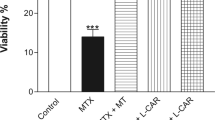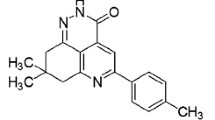Abstract
In the present study the formation and the effects of cyclophosphamide-derived acrolein were investigated using isolated cells from rat liver and kidney, with particular regard to the protective action of low molecular weight thiols against cellular toxicity. The results may be summarized as follows:
-
(a)
Cyclophosphamide (CTX)-mediated toxicity to isolated cells is dependent on cytochrome P-450 activity;
-
(b)
Loss of viability in cells incubated with cyclophosphamide is preceded by a depletion of cellular GSH;
-
(c)
Stimulation of cellular GSH synthesis or the presence of low molecular weight thiols in the incubation medium protects against cyclophosphamide-induced toxicity;
-
(d)
Acrolein is probably formed extracellularly as well as intracellularly and can be detoxified by thiol compounds, forming a thiochemiacetal or a thioether.
Similar content being viewed by others
References
Berrigan MJ, Marinello AJ, Pavelic Z, Williams CJ, Struck RF, Gurtoo HL (1982) Protective role of thiols in cyclophosphamide-induced urotoxicity and depression of hepatic drug metabolism. Cancer Res 42: 3688–3695
Brock N (1980) The development of mesna for the inhibition of urotoxic side effects of cyclophosphamide, ifosfamide, and other oxazaphosphorine cytostatics. In: G Mathei, FM Muggia (ededs), Cancer Chemo- and Immunopharmacology, p 274, Berlin, Springer-Verlag
Brock N, Stekar J, Pohl J, Niemeyer U, Scheffler G (1979) Acrolein, the causative factor of urotoxic side effects of cyclophosphamide, ifosfamide, trofosfamide and sulfosfamide. Drug Res 29: 659–661
Cox PJ (1979) Cyclophosphamide cystitis — Identification of acrolein as the causative agent. Biochem Pharmacol 28: 2045–2049
Cox PJ, Phillips BJ, Thomas P (1975) The enzymatic basis of the selective action of cyclophosphamide. Cancer Res 35: 3755–3761
Gurtoo HL, Hipkens JH, Sharma SD (1981) Role of glutathione in the metabolism-dependent toxicity and chemotherapy of cyclophosphamide. Cancer Res 41: 3584–3591
Hissin PJ, Hilf R (1976) A fluorometric method for determination of oxidized and reduced glutathione in tissues. Anal Biochem 74: 214–226
Hohorst HJ, Stoger V, Peters G, Völker G (1976) The problem of oncostatic specificity of cyclophosphamide (NSC-26271): Studies on reactions on the control of the alkylating and cytotoxic activity. Cancer Treat Rep 60: 309–315
Högberg J, Kristoferson A (1977) A correlation between glutathione levels and cellular damage in isolated hepatocytes. Eur J Biochem 74: 77–82
Izard C, Liberman C (1978) Acrolein. Mutat Res 47: 115–138
Jones DP, Sundby G-B, Ormstad K, Orrenius S (1979) Use of isolated kidney cells for study of drug metabolism. Biochem Pharmacol 28: 929–935
Moldéus P, Högberg J, Orrenius S (1978) Isolation and use of liver cells. Meth Enzymol LII: 60–71
Ohno Y, Ormstad K, Ross D, Orrenius S 1985 Mechanism of allyl alcohol toxicity and protective effects of low-molecular weight thiols studied with isolated rat hepatocytes. Toxicol Appl Pharmacol (in press)
Ormstad K, Orrenius S, Lastbom T, Uehara N, Pohl J, Stekar J, Brock N (1983) Pharmacokinetics and metabolism of sodium 2-mercaptoethane sulfonate in the rat. Cancer Res 43: 333–338
Reed DJ, Babson JR, Beatty PW, Brodie AE, Ellis WW, Potter DW (1980) High-performance liquid chromatography analysis of nanomole levels of glutathione, glutathione disulfide, and related thiols and disulfides. Anal Biochem 106: 55–62
Sladek NE (1971) Metabolism of cyclophosphamide by rat hepatic microsomes. Cancer Res 31: 901–908
Völker G, Dräger V, Peter G, Hohorst HJ (1974) Studien zum Spontanzerfall von 4-Hydroxycyclophosphamid und 4-Hydroperoxycyclophosphamid mit Hilfe der Dünnschichtchromatographie. Arzneim-Forsch/Drug Res 24: 1172–1176
Wildenauer DB, Oehlmann CE (1982) Interaction of cyclophosphamide metabolites with membrane proteins: An in vitro study with rabbit liver microsomes and human red blood cells — Effect of thiols. Biochem Pharmacol 31: 3535–3541
Zitting A, Heinonen T (1980) Decrease of reduced glutathione in isolated rat hepatocytes caused by acrolein, acrylonitrile and the normal thermal degradation products of styrene eopolymers. Toxicology 17: 333–341
Author information
Authors and Affiliations
Additional information
This work was funded by the Swedish National Board for technical Development (project no. 80-4542, 81-3328) and the Swedish Medical Research Council (grant no. = X3-2471)
Rights and permissions
About this article
Cite this article
Ohno, Y., Ormstad, K. Formation, toxicity and inactivation of acrolein during biotransformation of cyclophosphamide as studied in freshly isolated cells from rat liver and kidney. Arch Toxicol 57, 99–103 (1985). https://doi.org/10.1007/BF00343118
Received:
Accepted:
Issue Date:
DOI: https://doi.org/10.1007/BF00343118




